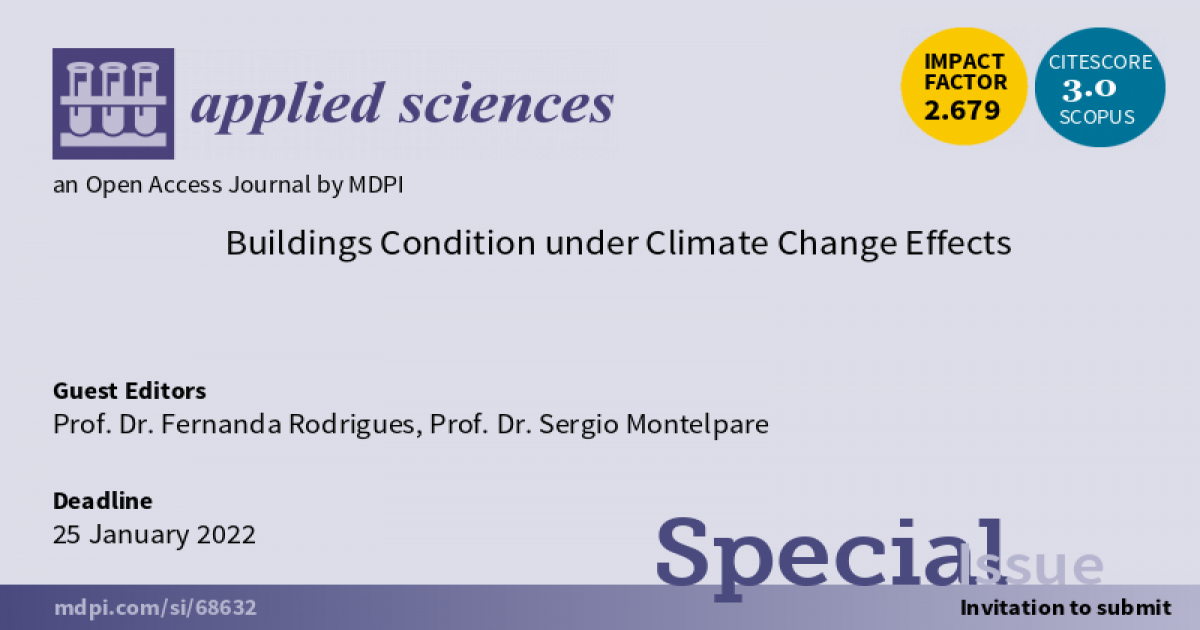Buildings Condition under Climate Change Effects
A special issue of Applied Sciences (ISSN 2076-3417). This special issue belongs to the section "Environmental Sciences".
Deadline for manuscript submissions: closed (30 December 2022) | Viewed by 9402
Related Special Issue: Impact Assessment of Climate Change on Buildings

Special Issue Editors
Interests: energy efficiency; BIM; buildings degradation assessment; buildings conservation and maintenance
Special Issues, Collections and Topics in MDPI journals
Interests: climate change; building sustainability; nZEB design; renewable energies; cultural heritage preservation; building acoustics
Special Issues, Collections and Topics in MDPI journals
Special Issue Information
Dear Colleagues,
In December 2019, the European Commission defined the European Green Deal, establishing an ambitious set of measures for the European Union and its citizens to face the challenges brought forth by climate change and making Europe free of net emissions of greenhouse gases by 2050. Considering the impact of the built environment and particularly that of buildings, identifying an efficient way to build and renovate is an important element of the Green Deal. A bit mor recently, in October 2020, the Renovation Wave for Europe was also published, aiming at “breaking down long-standing barriers to energy and resource-efficient renovation, supporting fresh investment over a sustained period starting from public and less efficient buildings, spurring digitalisation and creating employment and growth opportunities across the renovation supply chain”. In the context of the COVID-19 pandemic, it has been further recognized that that building renovation can lead to healthier, greener buildings that are more resilient to extreme natural events.
It is our pleasure to announce that we are organizing a Special Issue entitled “Condition of Buildings under Climate Change Effects”, aimed at reporting the most recent findings from researchers and professionals of the AECO sector in the scope of the following themes.
- Resource-efficient renovation;
- Indoor housing health and comfort;
- Social housing degradation and performance;
- Degradation and durability of the built environment under the influence of climate change;
- Climate change risks: built environment risk assessment;
- The impact of climate change on comfort: building level;
- The impact of climate change on comfort: city level;
- Climate change impact on the energy efficiency of buildings;
- Climate change impact on the durability of the built environment;
- Durability of energy retrofit interventions;
- Maintenance and refurbishment measures to avoid the impact of climate change;
- BIM as a tool for built environment risk assessment;
- HBIM in heritage renovation;
- Sustainability with BIM methodology;
- Approaches for the simulation of climate impacts on the built environment;
- Case studies and other related topics.
Prof. Dr. Fernanda Rodrigues
Prof. Dr. Sergio Montelpare
Guest Editors
Manuscript Submission Information
Manuscripts should be submitted online at www.mdpi.com by registering and logging in to this website. Once you are registered, click here to go to the submission form. Manuscripts can be submitted until the deadline. All submissions that pass pre-check are peer-reviewed. Accepted papers will be published continuously in the journal (as soon as accepted) and will be listed together on the special issue website. Research articles, review articles as well as short communications are invited. For planned papers, a title and short abstract (about 100 words) can be sent to the Editorial Office for announcement on this website.
Submitted manuscripts should not have been published previously, nor be under consideration for publication elsewhere (except conference proceedings papers). All manuscripts are thoroughly refereed through a single-blind peer-review process. A guide for authors and other relevant information for submission of manuscripts is available on the Instructions for Authors page. Applied Sciences is an international peer-reviewed open access semimonthly journal published by MDPI.
Please visit the Instructions for Authors page before submitting a manuscript. The Article Processing Charge (APC) for publication in this open access journal is 2400 CHF (Swiss Francs). Submitted papers should be well formatted and use good English. Authors may use MDPI's English editing service prior to publication or during author revisions.
Keywords
- buildings
- resource-efficient renovation
- risks
- resilience
- durability
- maintenance, assessment, climate change
Benefits of Publishing in a Special Issue
- Ease of navigation: Grouping papers by topic helps scholars navigate broad scope journals more efficiently.
- Greater discoverability: Special Issues support the reach and impact of scientific research. Articles in Special Issues are more discoverable and cited more frequently.
- Expansion of research network: Special Issues facilitate connections among authors, fostering scientific collaborations.
- External promotion: Articles in Special Issues are often promoted through the journal's social media, increasing their visibility.
- e-Book format: Special Issues with more than 10 articles can be published as dedicated e-books, ensuring wide and rapid dissemination.
Further information on MDPI's Special Issue polices can be found here.






